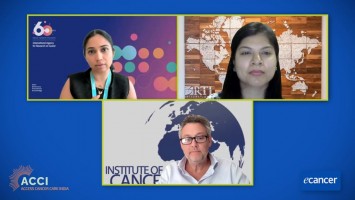That's another topic I'm interested in because again Romania doesn't have a national screening programme for breast carcinoma so we have a lot of tumours, malignant tumours, of cancers. Those ones are detected in late stage, unfortunately, and they also are related to high mortality. When you deal with breast carcinoma you also deal with the mimics, so this topic is related to the mimics, the lesions that are benign and should not be confused with the malignant ones. So that's why this is a more academic didactical approach and this lecture will be very good for residents and young specialists to be able to diagnose properly breast carcinoma and to exclude these ones that are only mimicking invasive carcinomas.
What kind of hallmarks should they be looking for to tell the difference?
Radiologically they can mimic, so first of all we need good radiologists to detect them and to differentiate them. But then pathologically when you grow the surgical specimen they can mimic an invasive lesion as well and then in the microscopy if you are not very experienced they can also mimic. So you have to have experience to diagnose them properly and then you have to use a couple of markers of antibodies. Ancillary studies show that you have to use more than two or three markers to be sure that they are not invasive.
Do you think there is opportunity to develop international training around this topic?
Absolutely, absolutely, and I personally think that we need training for young people, young pathologists and residents, to let them know that these lesions are not malignant and they should not be diagnosed as malignant. Because in the breast the problem is that as soon as you diagnose a malignancy, first of all the treatment, the surgical treatment, will be radical so you will do probably even a mastectomy in my country. Secondly you don't want to treat, oncologically treat, that patient for something that is not malignant. So you want to avoid all these things and that's very important to be able to diagnose pseudo-invasive versus real malignant lesions.
Any final thoughts?
Being for the first time here at the congress I truly appreciate this kind of congress. Why is that? Because this is a multidisciplinary congress and for the breast and the gyn this is the ideal situation in which you have a team working together. You have the surgeon, the oncologist, the pathologist, the radiologist and this for the breast especially but also for the gyn, this is the ideal situation. I really want to congratulate the President and the organising committee for having such a wonderful idea to put them all together to be able to attend multiple sessions and eventually to work as a team.








